Tanenbaum A. Computer Networks
Подождите немного. Документ загружается.

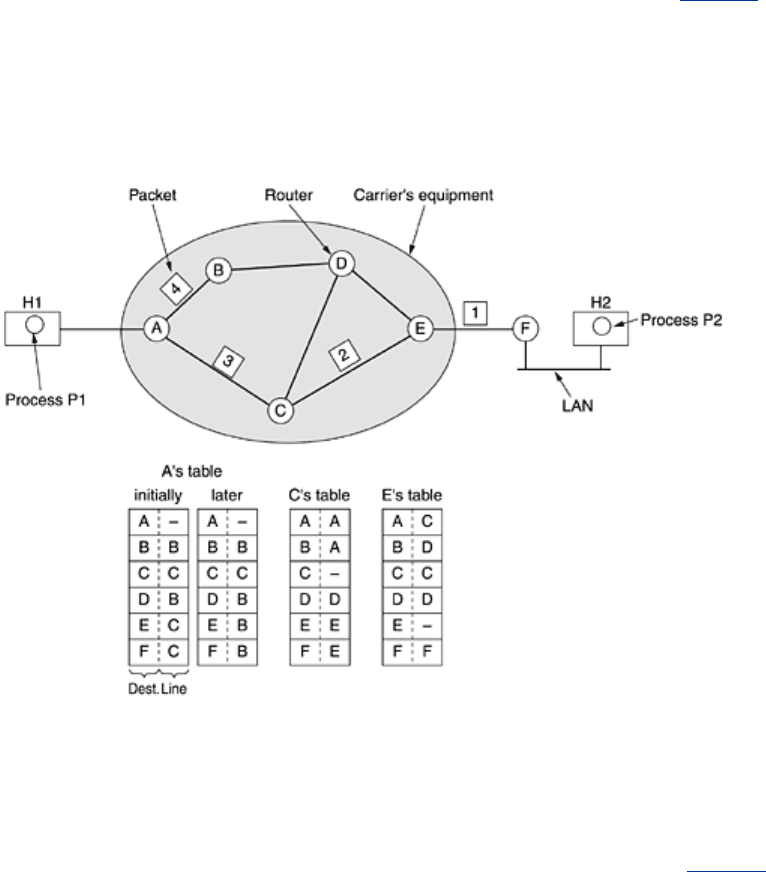
source router to the destination router must be established before any data packets can be
sent. This connection is called a
VC (virtual circuit), in analogy with the physical circuits set
up by the telephone system, and the subnet is called a
virtual-circuit subnet. In this section
we will examine datagram subnets; in the next one we will examine virtual-circuit subnets.
Let us now see how a datagram subnet works. Suppose that the process
P1 in Fig. 5-2 has a
long message for
P2. It hands the message to the transport layer with instructions to deliver it
to process
P2 on host H2. The transport layer code runs on H1, typically within the operating
system. It prepends a transport header to the front of the message and hands the result to the
network layer, probably just another procedure within the operating system.
Figure 5-2. Routing within a datagram subnet.
Let us assume that the message is four times longer than the maximum packet size, so the
network layer has to break it into four packets, 1, 2, 3, and 4 and sends each of them in turn
to router
A using some point-to-point protocol, for example, PPP. At this point the carrier takes
over. Every router has an internal table telling it where to send packets for each possible
destination. Each table entry is a pair consisting of a destination and the outgoing line to use
for that destination. Only directly-connected lines can be used. For example, in
Fig. 5-2, A has
only two outgoing lines—to
B and C—so every incoming packet must be sent to one of these
routers, even if the ultimate destination is some other router.
A's initial routing table is shown
in the figure under the label ''initially.''
As they arrived at
A, packets 1, 2, and 3 were stored briefly (to verify their checksums). Then
each was forwarded to
C according to A's table. Packet 1 was then forwarded to E and then to
F. When it got to F, it was encapsulated in a data link layer frame and sent to H2 over the LAN.
Packets 2 and 3 follow the same route.
However, something different happened to packet 4. When it got to
A it was sent to router B,
even though it is also destined for
F. For some reason, A decided to send packet 4 via a
different route than that of the first three. Perhaps it learned of a traffic jam somewhere along
the
ACE path and updated its routing table, as shown under the label ''later.'' The algorithm
that manages the tables and makes the routing decisions is called the
routing algorithm.
Routing algorithms are one of the main things we will study in this chapter.
261
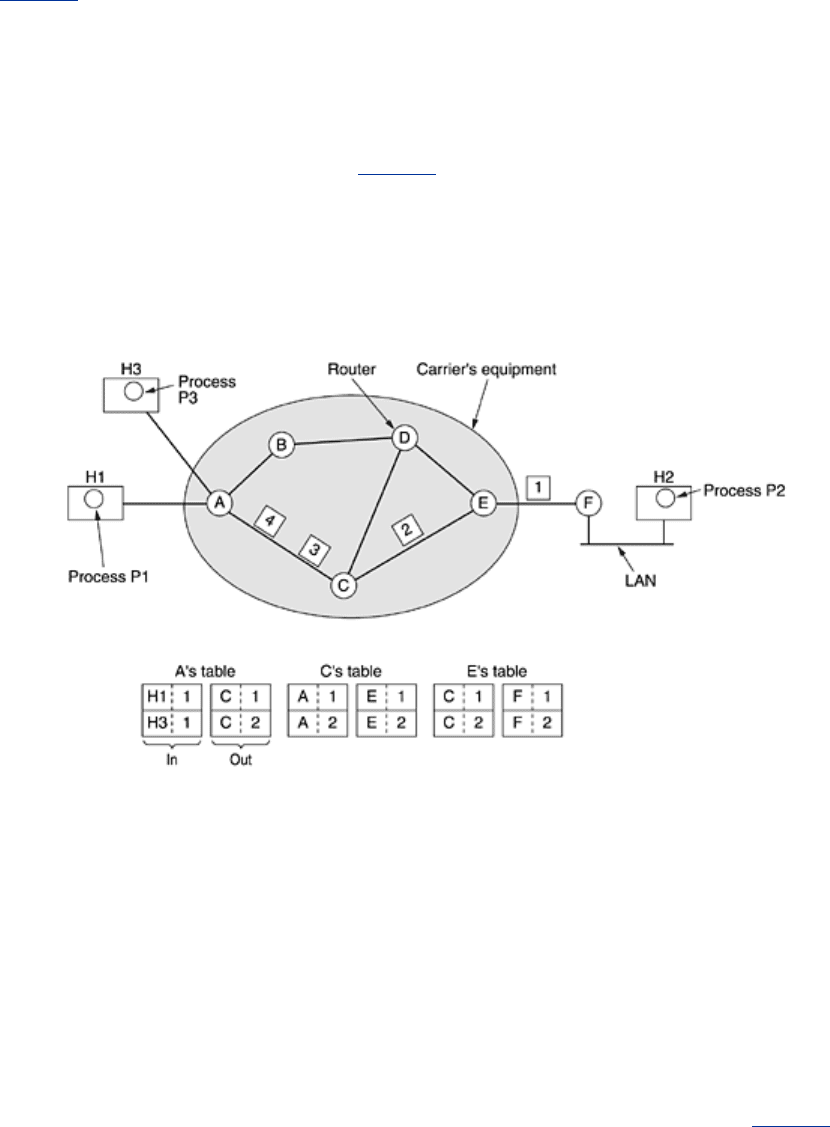
5.1.4 Implementation of Connection-Oriented Service
For connection-oriented service, we need a virtual-circuit subnet. Let us see how that works.
The idea behind virtual circuits is to avoid having to choose a new route for every packet sent,
as in
Fig. 5-2. Instead, when a connection is established, a route from the source machine to
the destination machine is chosen as part of the connection setup and stored in tables inside
the routers. That route is used for all traffic flowing over the connection, exactly the same way
that the telephone system works. When the connection is released, the virtual circuit is also
terminated. With connection-oriented service, each packet carries an identifier telling which
virtual circuit it belongs to.
As an example, consider the situation of
Fig. 5-3. Here, host H1 has established connection 1
with host
H2. It is remembered as the first entry in each of the routing tables. The first line of
A's table says that if a packet bearing connection identifier 1 comes in from H1, it is to be sent
to router
C and given connection identifier 1. Similarly, the first entry at C routes the packet to
E, also with connection identifier 1.
Figure 5-3. Routing within a virtual-circuit subnet.
Now let us consider what happens if
H3 also wants to establish a connection to H2. It chooses
connection identifier 1 (because it is initiating the connection and this is its only connection)
and tells the subnet to establish the virtual circuit. This leads to the second row in the tables.
Note that we have a conflict here because although
A can easily distinguish connection 1
packets from
H1 from connection 1 packets from H3, C cannot do this. For this reason, A
assigns a different connection identifier to the outgoing traffic for the second connection.
Avoiding conflicts of this kind is why routers need the ability to replace connection identifiers in
outgoing packets. In some contexts, this is called label switching.
5.1.5 Comparison of Virtual-Circuit and Datagram Subnets
Both virtual circuits and datagrams have their supporters and their detractors. We will now
attempt to summarize the arguments both ways. The major issues are listed in
Fig. 5-4,
although purists could probably find a counterexample for everything in the figure.
Figure 5-4. Comparison of datagram and virtual-circuit subnets.
262
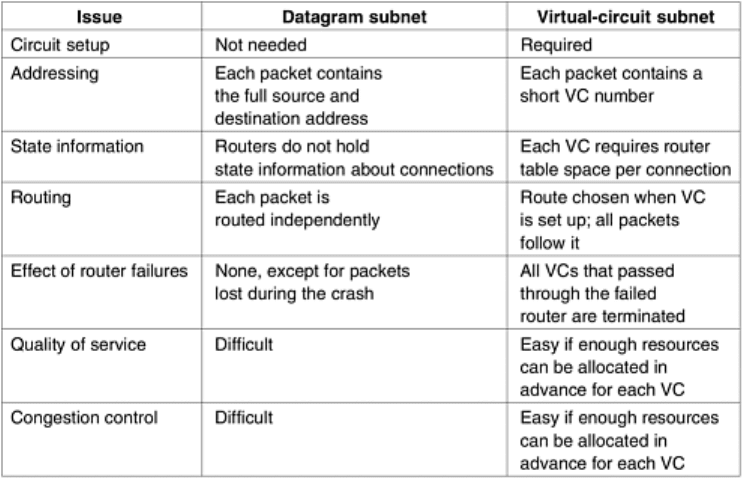
Inside the subnet, several trade-offs exist between virtual circuits and datagrams. One trade-
off is between router memory space and bandwidth. Virtual circuits allow packets to contain
circuit numbers instead of full destination addresses. If the packets tend to be fairly short, a
full destination address in every packet may represent a significant amount of overhead and
hence, wasted bandwidth. The price paid for using virtual circuits internally is the table space
within the routers. Depending upon the relative cost of communication circuits versus router
memory, one or the other may be cheaper.
Another trade-off is setup time versus address parsing time. Using virtual circuits requires a
setup phase, which takes time and consumes resources. However, figuring out what to do with
a data packet in a virtual-circuit subnet is easy: the router just uses the circuit number to
index into a table to find out where the packet goes. In a datagram subnet, a more
complicated lookup procedure is required to locate the entry for the destination.
Yet another issue is the amount of table space required in router memory. A datagram subnet
needs to have an entry for every possible destination, whereas a virtual-circuit subnet just
needs an entry for each virtual circuit. However, this advantage is somewhat illusory since
connection setup packets have to be routed too, and they use destination addresses, the same
as datagrams do.
Virtual circuits have some advantages in guaranteeing quality of service and avoiding
congestion within the subnet because resources (e.g., buffers, bandwidth, and CPU cycles) can
be reserved in advance, when the connection is established. Once the packets start arriving,
the necessary bandwidth and router capacity will be there. With a datagram subnet,
congestion avoidance is more difficult.
For transaction processing systems (e.g., stores calling up to verify credit card purchases), the
overhead required to set up and clear a virtual circuit may easily dwarf the use of the circuit. If
the majority of the traffic is expected to be of this kind, the use of virtual circuits inside the
subnet makes little sense. On the other hand, permanent virtual circuits, which are set up
manually and last for months or years, may be useful here.
Virtual circuits also have a vulnerability problem. If a router crashes and loses its memory,
even if it comes back up a second later, all the virtual circuits passing through it will have to be
aborted. In contrast, if a datagram router goes down, only those users whose packets were
queued in the router at the time will suffer, and maybe not even all those, depending upon
whether they have already been acknowledged. The loss of a communication line is fatal to
263

virtual circuits using it but can be easily compensated for if datagrams are used. Datagrams
also allow the routers to balance the traffic throughout the subnet, since routes can be
changed partway through a long sequence of packet transmissions.
5.2 Routing Algorithms
The main function of the network layer is routing packets from the source machine to the
destination machine. In most subnets, packets will require multiple hops to make the journey.
The only notable exception is for broadcast networks, but even here routing is an issue if the
source and destination are not on the same network. The algorithms that choose the routes
and the data structures that they use are a major area of network layer design.
The
routing algorithm is that part of the network layer software responsible for deciding
which output line an incoming packet should be transmitted on. If the subnet uses datagrams
internally, this decision must be made anew for every arriving data packet since the best route
may have changed since last time. If the subnet uses virtual circuits internally, routing
decisions are made only when a new virtual circuit is being set up. Thereafter, data packets
just follow the previously-established route. The latter case is sometimes called
session
routing
because a route remains in force for an entire user session (e.g., a login session at a
terminal or a file transfer).
It is sometimes useful to make a distinction between routing, which is making the decision
which routes to use, and forwarding, which is what happens when a packet arrives. One can
think of a router as having two processes inside it. One of them handles each packet as it
arrives, looking up the outgoing line to use for it in the routing tables. This process is
forwarding. The other process is responsible for filling in and updating the routing tables.
That is where the routing algorithm comes into play.
Regardless of whether routes are chosen independently for each packet or only when new
connections are established, certain properties are desirable in a routing algorithm:
correctness, simplicity, robustness, stability, fairness, and optimality. Correctness and
simplicity hardly require comment, but the need for robustness may be less obvious at first.
Once a major network comes on the air, it may be expected to run continuously for years
without systemwide failures. During that period there will be hardware and software failures of
all kinds. Hosts, routers, and lines will fail repeatedly, and the topology will change many
times. The routing algorithm should be able to cope with changes in the topology and traffic
without requiring all jobs in all hosts to be aborted and the network to be rebooted every time
some router crashes.
Stability is also an important goal for the routing algorithm. There exist routing algorithms that
never converge to equilibrium, no matter how long they run. A stable algorithm reaches
equilibrium and stays there. Fairness and optimality may sound obvious—surely no reasonable
person would oppose them—but as it turns out, they are often contradictory goals. As a simple
example of this conflict, look at
Fig. 5-5. Suppose that there is enough traffic between A and
A', between B and B', and between C and C' to saturate the horizontal links. To maximize the
total flow, the
X to X' traffic should be shut off altogether. Unfortunately, X and X' may not see
it that way. Evidently, some compromise between global efficiency and fairness to individual
connections is needed.
Figure 5-5. Conflict between fairness and optimality.
264

Before we can even attempt to find trade-offs between fairness and optimality, we must decide
what it is we seek to optimize. Minimizing mean packet delay is an obvious candidate, but so is
maximizing total network throughput. Furthermore, these two goals are also in conflict, since
operating any queueing system near capacity implies a long queueing delay. As a compromise,
many networks attempt to minimize the number of hops a packet must make, because
reducing the number of hops tends to improve the delay and also reduce the amount of
bandwidth consumed, which tends to improve the throughput as well.
Routing algorithms can be grouped into two major classes: nonadaptive and adaptive.
Nonadaptive algorithms do not base their routing decisions on measurements or estimates
of the current traffic and topology. Instead, the choice of the route to use to get from
I to J
(for all
I and J) is computed in advance, off-line, and downloaded to the routers when the
network is booted. This procedure is sometimes called
static routing.
Adaptive algorithms, in contrast, change their routing decisions to reflect changes in the
topology, and usually the traffic as well. Adaptive algorithms differ in where they get their
information (e.g., locally, from adjacent routers, or from all routers), when they change the
routes (e.g., every ∆
T sec, when the load changes or when the topology changes), and what
metric is used for optimization (e.g., distance, number of hops, or estimated transit time). In
the following sections we will discuss a variety of routing algorithms, both static and dynamic.
5.2.1 The Optimality Principle
Before we get into specific algorithms, it may be helpful to note that one can make a general
statement about optimal routes without regard to network topology or traffic. This statement is
known as the
optimality principle. It states that if router J is on the optimal path from router
I to router K, then the optimal path from J to K also falls along the same route. To see this,
call the part of the route from
I to Jr
1
and the rest of the route r
2
. If a route better than r
2
existed from
J to K, it could be concatenated with r
1
to improve the route from I to K,
contradicting our statement that
r
1
r
2
is optimal.
As a direct consequence of the optimality principle, we can see that the set of optimal routes
from all sources to a given destination form a tree rooted at the destination. Such a tree is
called a
sink tree and is illustrated in Fig. 5-6, where the distance metric is the number of
hops. Note that a sink tree is not necessarily unique; other trees with the same path lengths
may exist. The goal of all routing algorithms is to discover and use the sink trees for all
routers.
Figure 5-6. (a) A subnet. (b) A sink tree for router B.
265
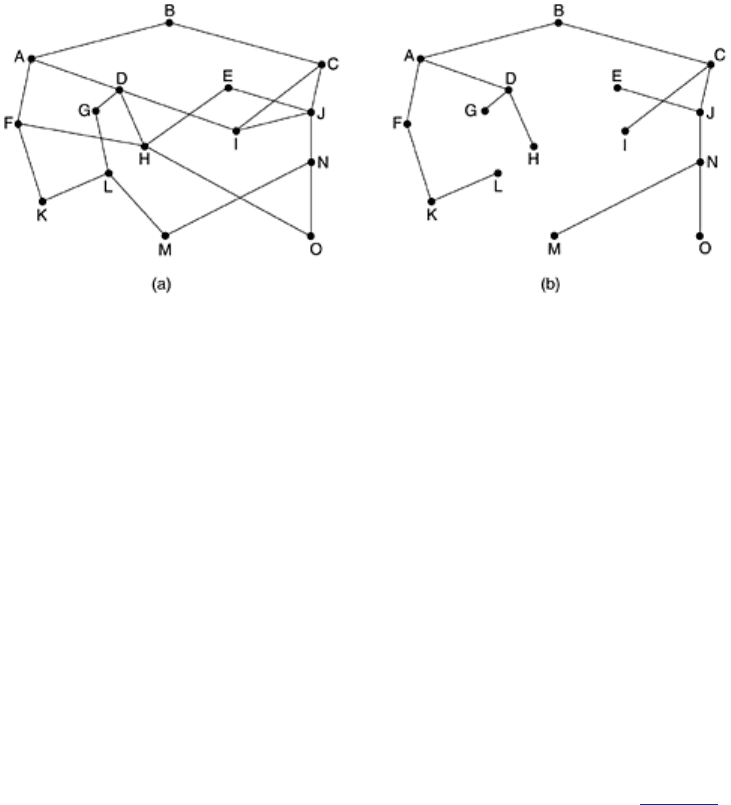
Since a sink tree is indeed a tree, it does not contain any loops, so each packet will be
delivered within a finite and bounded number of hops. In practice, life is not quite this easy.
Links and routers can go down and come back up during operation, so different routers may
have different ideas about the current topology. Also, we have quietly finessed the issue of
whether each router has to individually acquire the information on which to base its sink tree
computation or whether this information is collected by some other means. We will come back
to these issues shortly. Nevertheless, the optimality principle and the sink tree provide a
benchmark against which other routing algorithms can be measured.
5.2.2 Shortest Path Routing
Let us begin our study of feasible routing algorithms with a technique that is widely used in
many forms because it is simple and easy to understand. The idea is to build a graph of the
subnet, with each node of the graph representing a router and each arc of the graph
representing a communication line (often called a link). To choose a route between a given
pair of routers, the algorithm just finds the shortest path between them on the graph.
The concept of a
shortest path deserves some explanation. One way of measuring path
length is the number of hops. Using this metric, the paths
ABC and ABE in Fig. 5-7 are equally
long. Another metric is the geographic distance in kilometers, in which case
ABC is clearly
much longer than
ABE (assuming the figure is drawn to scale).
Figure 5-7. The first five steps used in computing the shortest path
from
A to D. The arrows indicate the working node.
266
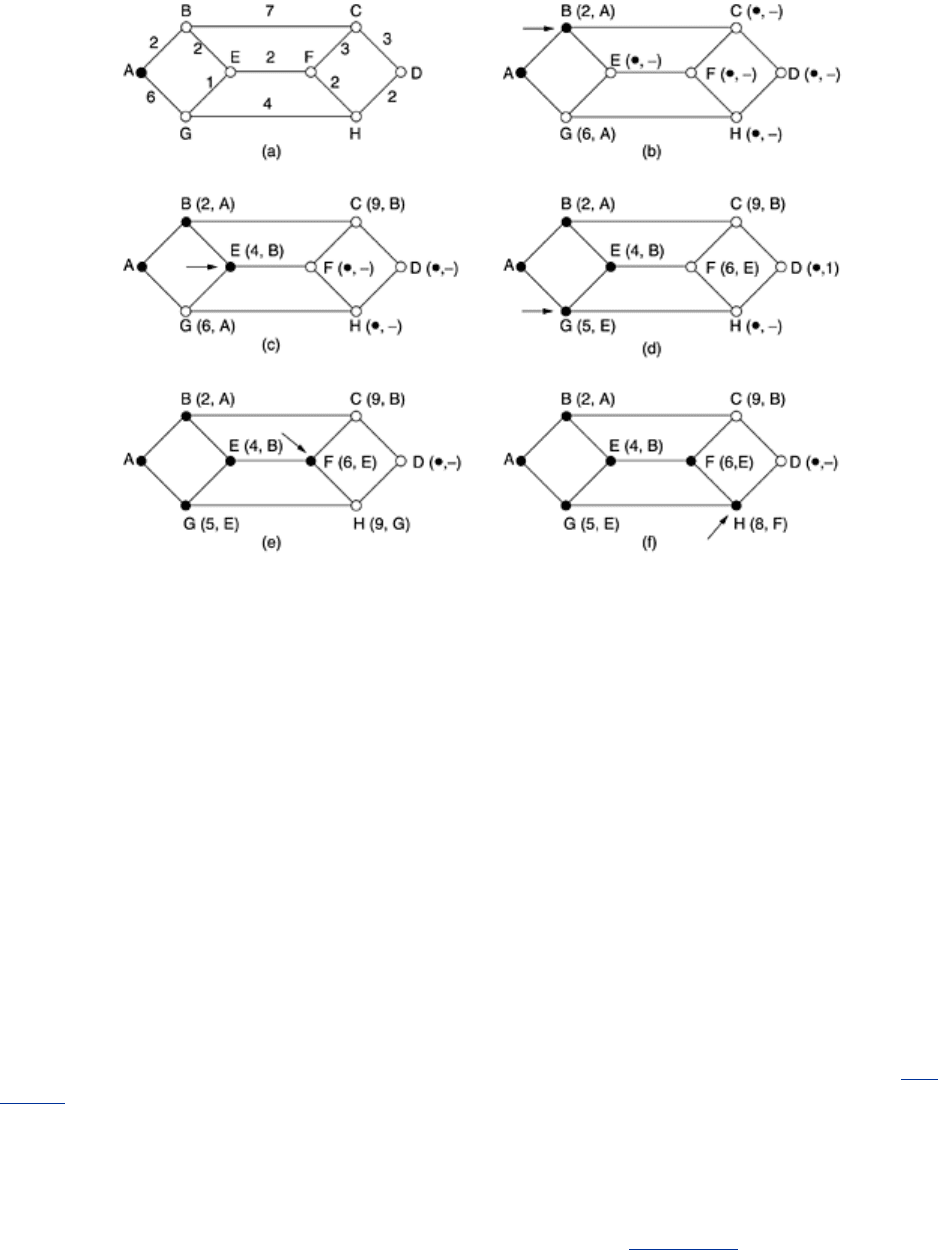
However, many other metrics besides hops and physical distance are also possible. For
example, each arc could be labeled with the mean queueing and transmission delay for some
standard test packet as determined by hourly test runs. With this graph labeling, the shortest
path is the fastest path rather than the path with the fewest arcs or kilometers.
In the general case, the labels on the arcs could be computed as a function of the distance,
bandwidth, average traffic, communication cost, mean queue length, measured delay, and
other factors. By changing the weighting function, the algorithm would then compute the
''shortest'' path measured according to any one of a number of criteria or to a combination of
criteria.
Several algorithms for computing the shortest path between two nodes of a graph are known.
This one is due to Dijkstra (1959). Each node is labeled (in parentheses) with its distance from
the source node along the best known path. Initially, no paths are known, so all nodes are
labeled with infinity. As the algorithm proceeds and paths are found, the labels may change,
reflecting better paths. A label may be either tentative or permanent. Initially, all labels are
tentative. When it is discovered that a label represents the shortest possible path from the
source to that node, it is made permanent and never changed thereafter.
To illustrate how the labeling algorithm works, look at the weighted, undirected graph of
Fig.
5-7(a), where the weights represent, for example, distance. We want to find the shortest path
from
A to D. We start out by marking node A as permanent, indicated by a filled-in circle. Then
we examine, in turn, each of the nodes adjacent to
A (the working node), relabeling each one
with the distance to
A. Whenever a node is relabeled, we also label it with the node from which
the probe was made so that we can reconstruct the final path later. Having examined each of
the nodes adjacent to
A, we examine all the tentatively labeled nodes in the whole graph and
make the one with the smallest label permanent, as shown in
Fig. 5-7(b). This one becomes
the new working node.
We now start at
B and examine all nodes adjacent to it. If the sum of the label on B and the
distance from
B to the node being considered is less than the label on that node, we have a
shorter path, so the node is relabeled.
267

After all the nodes adjacent to the working node have been inspected and the tentative labels
changed if possible, the entire graph is searched for the tentatively-labeled node with the
smallest value. This node is made permanent and becomes the working node for the next
round.
Figure 5-7 shows the first five steps of the algorithm.
To see why the algorithm works, look at
Fig. 5-7(c). At that point we have just made E
permanent. Suppose that there were a shorter path than
ABE, say AXYZE. There are two
possibilities: either node
Z has already been made permanent, or it has not been. If it has,
then
E has already been probed (on the round following the one when Z was made
permanent), so the
AXYZE path has not escaped our attention and thus cannot be a shorter
path.
Now consider the case where
Z is still tentatively labeled. Either the label at Z is greater than
or equal to that at
E, in which case AXYZE cannot be a shorter path than ABE, or it is less than
that of
E, in which case Z and not E will become permanent first, allowing E to be probed from
Z.
This algorithm is given in
Fig. 5-8. The global variables n and dist describe the graph and are
initialized before
shortest_path is called. The only difference between the program and the
algorithm described above is that in
Fig. 5-8, we compute the shortest path starting at the
terminal node,
t, rather than at the source node, s. Since the shortest path from t to s in an
undirected graph is the same as the shortest path from
s to t, it does not matter at which end
we begin (unless there are several shortest paths, in which case reversing the search might
discover a different one). The reason for searching backward is that each node is labeled with
its predecessor rather than its successor. When the final path is copied into the output
variable,
path, the path is thus reversed. By reversing the search, the two effects cancel, and
the answer is produced in the correct order.
Figure 5-8. Dijkstra's algorithm to compute the shortest path through
a graph.
268
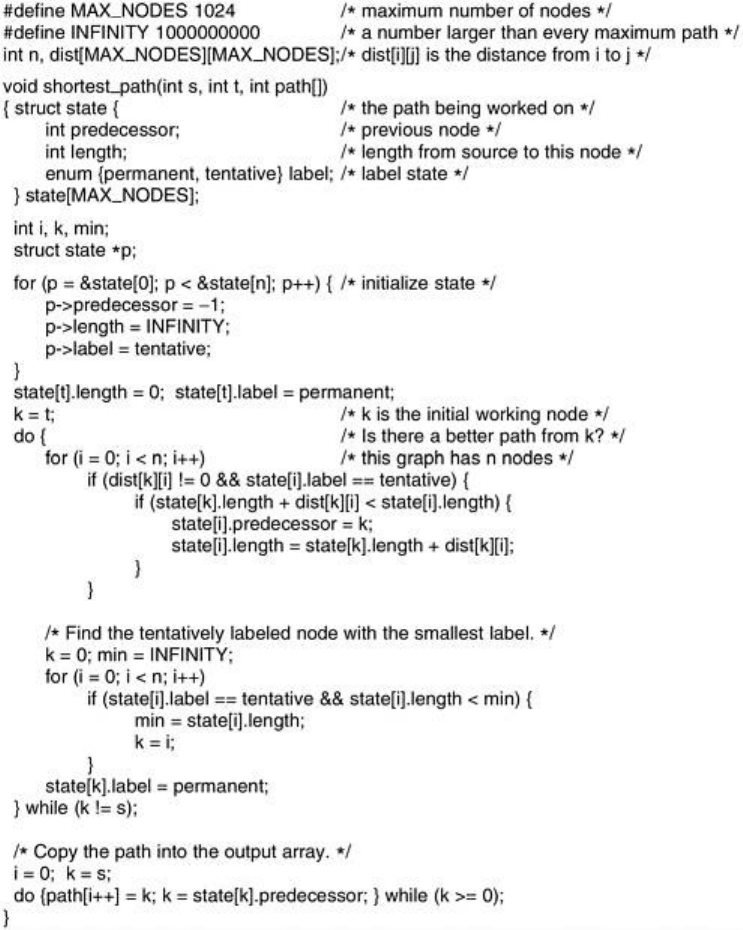
5.2.3 Flooding
Another static algorithm is flooding, in which every incoming packet is sent out on every
outgoing line except the one it arrived on. Flooding obviously generates vast numbers of
duplicate packets, in fact, an infinite number unless some measures are taken to damp the
process. One such measure is to have a hop counter contained in the header of each packet,
which is decremented at each hop, with the packet being discarded when the counter reaches
zero. Ideally, the hop counter should be initialized to the length of the path from source to
destination. If the sender does not know how long the path is, it can initialize the counter to
the worst case, namely, the full diameter of the subnet.
An alternative technique for damming the flood is to keep track of which packets have been
flooded, to avoid sending them out a second time. achieve this goal is to have the source
router put a sequence number in each packet it receives from its hosts. Each router then
needs a list per source router telling which sequence numbers originating at that source have
already been seen. If an incoming packet is on the list, it is not flooded.
269
To prevent the list from growing without bound, each list should be augmented by a counter,
k, meaning that all sequence numbers through k have been seen. When a packet comes in, it
is easy to check if the packet is a duplicate; if so, it is discarded. Furthermore, the full list
below
k is not needed, since k effectively summarizes it.
A variation of flooding that is slightly more practical is
selective flooding.In this algorithm
the routers do not send every incoming packet out on every line, only on those lines that are
going approximately in the right direction. There is usually little point in sending a westbound
packet on an eastbound line unless the topology is extremely peculiar and the router is sure of
this fact.
Flooding is not practical in most applications, but it does have some uses. For example, in
military applications, where large numbers of routers may be blown to bits at any instant, the
tremendous robustness of flooding is highly desirable. In distributed database applications, it is
sometimes necessary to update all the databases concurrently, in which case flooding can be
useful. In wireless networks, all messages transmitted by a station can be received by all other
stations within its radio range, which is, in fact, flooding, and some algorithms utilize this
property. A fourth possible use of flooding is as a metric against which other routing
algorithms can be compared. Flooding always chooses the shortest path because it chooses
every possible path in parallel. Consequently, no other algorithm can produce a shorter delay
(if we ignore the overhead generated by the flooding process itself).
5.2.4 Distance Vector Routing
Modern computer networks generally use dynamic routing algorithms rather than the static
ones described above because static algorithms do not take the current network load into
account. Two dynamic algorithms in particular, distance vector routing and link state routing,
are the most popular. In this section we will look at the former algorithm. In the following
section we will study the latter algorithm.
Distance vector routing algorithms operate by having each router maintain a table (i.e, a
vector) giving the best known distance to each destination and which line to use to get there.
These tables are updated by exchanging information with the neighbors.
The distance vector routing algorithm is sometimes called by other names, most commonly the
distributed
Bellman-Ford routing algorithm and the Ford-Fulkerson algorithm, after the
researchers who developed it (Bellman, 1957; and Ford and Fulkerson, 1962). It was the
original ARPANET routing algorithm and was also used in the Internet under the name RIP.
In distance vector routing, each router maintains a routing table indexed by, and containing
one entry for, each router in the subnet. This entry contains two parts: the preferred outgoing
line to use for that destination and an estimate of the time or distance to that destination. The
metric used might be number of hops, time delay in milliseconds, total number of packets
queued along the path, or something similar.
The router is assumed to know the ''distance'' to each of its neighbors. If the metric is hops,
the distance is just one hop. If the metric is queue length, the router simply examines each
queue. If the metric is delay, the router can measure it directly with special ECHO packets that
the receiver just timestamps and sends back as fast as it can.
As an example, assume that delay is used as a metric and that the router knows the delay to
each of its neighbors. Once every
T msec each router sends to each neighbor a list of its
estimated delays to each destination. It also receives a similar list from each neighbor.
Imagine that one of these tables has just come in from neighbor
X, with X
i
being X's estimate
of how long it takes to get to router
i. If the router knows that the delay to X is m msec, it also
knows that it can reach router
i via X in X
i
+ m msec. By performing this calculation for each
neighbor, a router can find out which estimate seems the best and use that estimate and the
270
